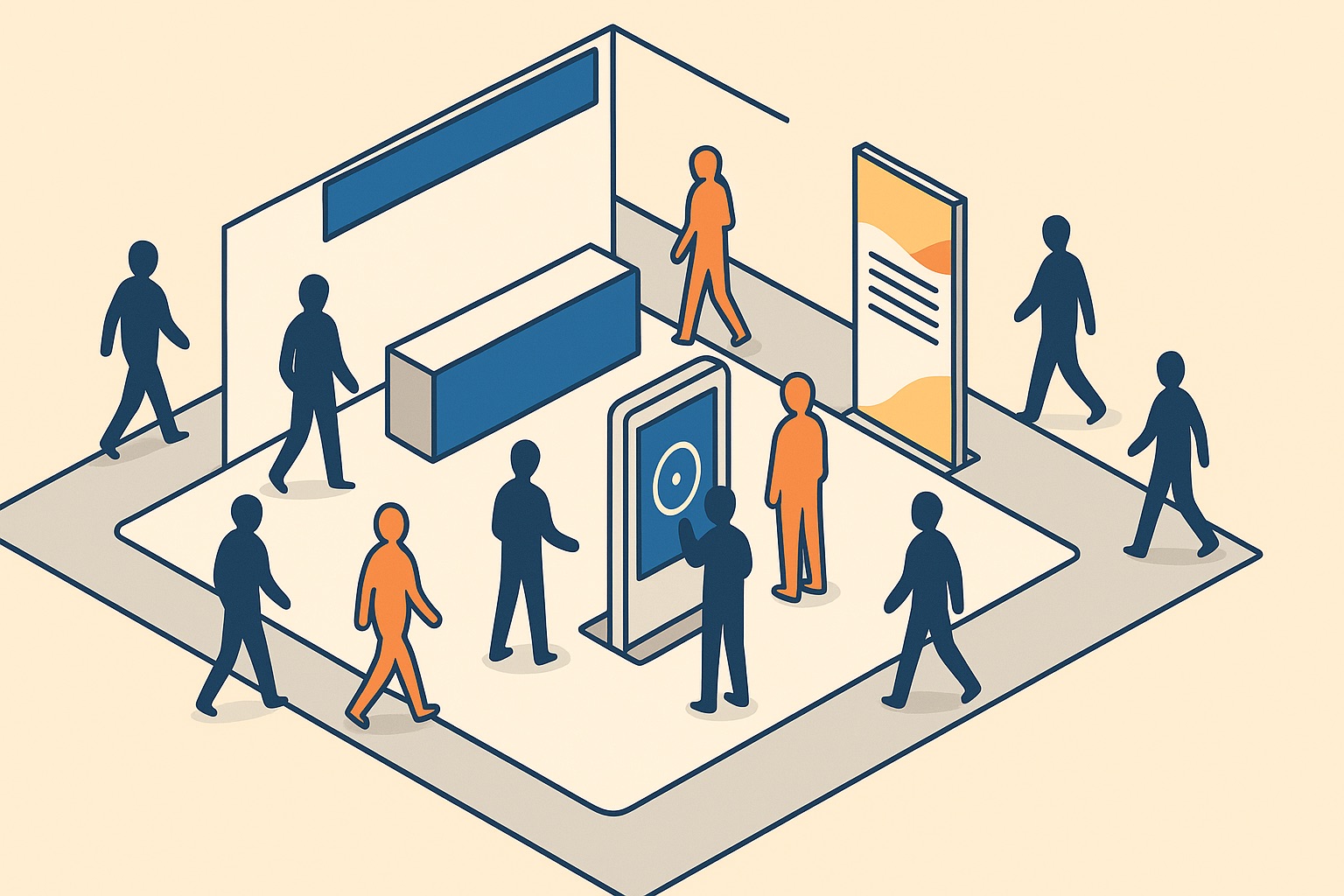The old trade show model is broken. A friendly smile and a stack of brochures no longer cut through the noise of a crowded expo hall. Booths are a major investment, yet many teams walk away with a handful of badge scans and little to show for it. The problem is relying on hope as a strategy.
Successful exhibitors know that trade show booth engagement isn’t just about having fun activities. It’s a deliberate system for attracting the right people, creating memorable interactions, and proving the return on your investment. It’s about turning a passive booth visit into an active brand experience.
This guide provides a simple framework to do just that. We’ll walk through how to connect your goals to your booth design, choose the right technology to spark interaction, and measure what matters.
Why Does Booth Engagement Matter?
Booth engagement turns passive attendees into active participants, creating memorable brand interactions that lead to better leads and measurable ROI. It’s about moving beyond a one-way sales pitch to build a genuine connection. When someone steps into your booth, you have a brief window to make an impression that sticks.
An engaging experience invites people into your brand's story. Instead of just hearing about your product, they get to see, touch, or play with it. This hands-on approach builds trust and creates a positive emotional connection—something a digital ad or a brochure can rarely achieve.
This shift delivers on a few key business goals:
- Higher Quality Leads: Engaged visitors are more likely to be genuinely interested. The interaction itself acts as a filter, helping you separate the curious from the committed.
- Increased Dwell Time: When people are having a good time, they stick around longer. This gives your sales team more opportunities for meaningful conversations.
- Better Brand Recall: People remember what they *do* far more than what they see. A positive, interactive memory keeps your brand top-of-mind long after the event ends.
How Do You Design a Booth for Interaction?
An interactive booth starts with a clear goal and a design that invites people in. It balances open space for traffic flow, clear messaging that can be understood in three seconds, and a central "hook" or activity that sparks curiosity and encourages participation.
Before you choose a single piece of furniture or tech, ask: What is the one thing we want people to do or feel here? The answer to that question should guide every design choice. Your booth’s layout should make that primary action obvious and easy.

Here are a few foundational design principles:
- Create an Open Flow: Avoid creating a "fortress" with a table blocking the entrance. Use an open layout that welcomes people in from the aisle without making them feel trapped. For a deeper look, our guide to trade show booth design covers these fundamentals.
- Use Clear, Simple Messaging: Your main value proposition should be visible from a distance. Use large, easy-to-read fonts and focus on benefits, not just features.
- Light It Up: Good lighting makes a booth feel more professional and inviting. Use spotlights to highlight your main interactive station or product demo area.
- Build Around a "Hook": Your booth needs a focal point. This is your primary interactive element - the thing that makes someone stop, look, and step inside. It could be a large touchscreen, a fun game, or a live demonstration. Consider using a digital photo booth for creating engaging, branded photo moments.
What Technology Should I Use to Engage Trade Show Attendees?
The best technology makes engagement easy for attendees and measurable for you. Instead of chasing the flashiest new gadget, focus on tools that solve a specific job. Most effective engagement tech falls into one of three categories: interactive displays, content creation tools, and gamification.
The key is to match the tool to your goal and your audience. A complex VR experience can be a showstopper, but it often creates long lines and serves only one person at a time. The trade-off is that simpler, more scalable web-based tools often engage more people and deliver a better return.

1. Interactive Displays for Self-Guided Exploration
Interactive touchscreens and kiosks are great for letting attendees explore information at their own pace. They turn a passive viewing experience into an active one, empowering visitors to find what’s most relevant to them.
- What they do: Allow users to browse product catalogs, watch video testimonials, or use an interactive product configurator to build a custom solution.
- Why they work: They reduce the pressure of a hard sell and give your booth staff more time to focus on deep, qualified conversations. Plus, you can track which content gets the most clicks, giving you valuable insight into attendee interests.
- Best for: Booths with complex products or multiple services to showcase.
2. Content Creation Tools for Brand Advocacy
These tools turn attendees into your best marketers by giving them a fun reason to create and share branded content. Modern photo and video booths are a perfect example, turning a simple photo op into a powerful engine for social sharing and lead capture. Try using an AI Video Booth to create instant, branded video reels for attendees.
- What they do: Allow guests to create branded photos, GIFs, or short video testimonials with custom overlays, digital props, or AI-generated backgrounds.
- Why they work: People love sharing cool content that makes them look good. When they post their branded photo, your event's reach extends organically to their entire network. It’s a natural, low-friction way to generate trade show leads.
- Best for: Driving brand awareness, generating user-generated content (UGC), and capturing leads in a "happy exchange."
3. Gamification for Driving Repeat Visits
Gamification adds an element of fun and friendly competition to your booth. Digital trivia, scavenger hunts, or a "spin-to-win" wheel can create a lively atmosphere that draws a crowd and encourages people to come back.
- What they do: Use challenges, leaderboards, and prizes to encourage deeper engagement with your brand messaging or product features. A digital scavenger hunt, for example, might use QR codes to guide attendees to different stations in your booth.
- Why they work: Competition is a powerful motivator. A simple game provides a great icebreaker for your team and a compelling reason for attendees to share their contact information to claim a prize.
- Best for: Increasing booth dwell time, creating a memorable and fun atmosphere, and capturing leads.
How Do I Measure ROI from Trade Show Booth Engagement?
You measure ROI by tracking metrics tied directly to your event goals. This involves capturing data through your interactive elements, tagging those leads in your CRM, and calculating the value of the sales pipeline generated against your total event investment. It’s the only way to prove your engagement strategy actually worked.
According to research from the Center for Exhibition Industry Research (CEIR), generating leads is the top priority for most B2B exhibitors. But a lead is only valuable if you can track it from the show floor to a closed deal.

Here’s a simple, three-step process to connect your engagement efforts to real financial results.
Step 1: Define Your KPIs Before the Event
Your Key Performance Indicators (KPIs) are the specific numbers you’ll track to measure success. Tie them directly to your main goal for the event.
- If your goal is Lead Generation: Your primary KPI is the Number of Marketing Qualified Leads (MQLs) captured. Secondary metrics could be Meetings Booked on-site or Cost Per Lead.
- If your goal is Brand Awareness: Your primary KPI is Social Media Reach & Impressions from shared content. Secondary metrics could be Website Traffic Lift during the event or Press Mentions.
Step 2: Capture Data with Your Engagement Tech
Your interactive technology should be your primary data capture tool. This is far more effective than just scanning badges of everyone who walks by.
For more insights on capturing structured attendee data, explore our methods for experiential lead capture.
- Require an email or badge scan to play a game.
- Ask for contact info to send a digital photo or video.
- Integrate a simple survey into your touchscreen kiosk.
Make sure your event tech integrates with your CRM. This automatically tags every lead with the event name, allowing you to track their journey accurately.
Step 3: Calculate the Return
Once the event is over and you’ve had time to follow up on leads, you can calculate your ROI.
- Calculate Total Event Investment: Add up everything—booth space, design, travel, tech, and even staff time.
- Calculate Your Return
- Pipeline Value: Multiply the number of MQLs by your average deal value.
- Earned Media Value: Estimate the value of your social impressions. (e.g., If you got 50,000 impressions and your average ad CPM is $20, that’s $1,000 in earned media value).
- Use the ROI Formula: `(Net Profit / Investment) x 100 = ROI %`
This process turns a subjective feeling of "a good show" into an objective, data-backed result you can share with stakeholders.
Final Thoughts
A great trade show booth is more than just a pretty space. It’s an engagement engine. By starting with a clear goal, designing for interaction, choosing tech that serves a purpose, and measuring the outcome, you can turn one of your biggest marketing expenses into one of your most valuable investments.
By choosing an engagement tool that aligns with your goals - like a simple, web-based photo booth for virtual and hybrid events - you can turn a fun moment into a measurable outcome.
Ready to put these ideas into action? Explore activation ideas that fit this approach.










-p-500.webp)



.jpeg)















